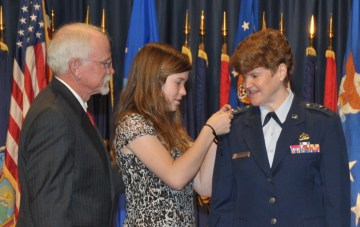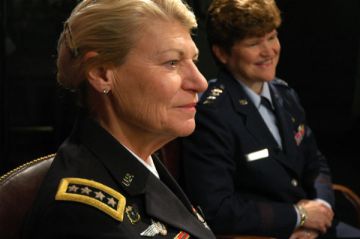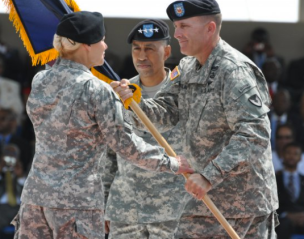Things certainly have changed since Janet Wolfenbarger walked up the long ramp at the Air Force Academy in 1976, under a sign declaring in two-foot high brushed aluminum letters: BRING ME MEN. She was one of 97 women in the 899-strong academy class of 1980 – the first ever to admit females. “When I came in, there was still an executive order on the books that if a woman became pregnant, she could be separated from service,” Wolfenbarger says. “Just think: in my lifetime, we have come from that point to where we are today, where we have two women four-stars.”
Wolfenbarger became the second female four-star general in the history of the U.S. military in June. She assumed her command just as the first female four-star in U.S. history, Army General Ann Dunwoody, prepared to leave hers. The pair met for the first time recently in the Pentagon basement, at Time’s invitation. “When I got promoted, I said `I might be the first, but I won’t be the last,’” Dunwoody exulted upon meeting her four-star sister for the first time. “And voila!” They looked at one another as if staring into a surreal mirror before joyfully embracing. “When we entered, it wasn’t a popular decision,” Dunwoody recalls. “But women showed that they could carry the same rucksack as their male counterparts.”
(MORE: The Nitty-Gritty of Women at War)

Air Force photo / Michelle Gigante
There are 1.4 million men and women in the U.S. military, but only 38 four-star officers, those generals and admirals who have reached the pinnacle of the profession of arms. In 2008, Dunwoody became the first woman in American history to enter this exclusive club. On June 5, Wolfenbarger joined her. With Dunwoody stepping down this month, the pair sat down together to talk about the challenges and rewards associated with climbing to the top of the male-dominated military culture.
They speak with a self-confidence tempered by decades in uniform, greased with easy laughter. Neither is in the Navy, so it’s not surprising they don’t rock the boat. Like most high-fliers in this most traditional of careers, they “stay inside their lanes,” as those in uniform like to say. They haven’t tried to change the military in their own way, so much as strived to fit and succeed inside its peculiar culture. Bottom line: they’ve spent decades trying to blend in, not stand out.
Wolfenbarger runs, and until last week Dunwoody ran, their services’ weapons-development and logistics operations. The coincidence is not surprising. Early in their careers, women were barred from combat — and in the Army they still are – ruling them out of most four-star billets. Dunwoody, 59, commanded 69,000 people as chief of Army Material Command from Alabama’s Redstone Arsenal until Aug. 7; her retirement ceremony is set for Wednesday in Washington. Wolfenbarger, 53, heads the Air Force Materiel Command at Wright-Patterson Air Force Base in Ohio, and its 83,000 civilian and military personnel.
(MORE: Women are Heroes, Too)
While the Army bars women from front-line units – infantry, armor, special operations – Dunwoody says there are no front lines anymore. “We’ve had over 250,000 deployed and 144 given their ultimate sacrifice,” she says of the post-9/11 wars. “I think some of our policies are lagging and are catching up with the current employment of women.”
They know they’ve become role models. “When young women wonder how high they can rise in our military,” First Lady Michelle Obama said in 2009, “they can look at General Ann Dunwoody and her four hard-earned stars. They can see that it’s real.”

photo by katy steinmetz
Both come from military families. “I have four generations of West Pointers in my family, so I probably have O.D.” – olive drab – “blood,” Dunwoody says. She is a graduate of the Pentagon-run Supreme Headquarters Allied Powers Europe American High School in Belgium, near NATO headquarters, and the State University of New York at Cortland. She joined the soon-to-disband Women’s Army Corps and spent more than three decades in the quartermaster corps keeping troops supplied.
Along the way, she became the first woman to command a battalion in the 82nd Airborne Division. She deployed to Saudi Arabia for 1991’s Gulf War, and to Uzbekistan to support the Afghan campaign. “I’ve had the privilege to go to Iraq and Afghanistan many times,” she said as she relinquished her command last week. “I got to meet with leaders one on one, and they all told me the same thing: they told me they never worried about logistics, and I can’t imagine a better compliment.”
(PHOTOS: Women of War)
While her brother went to West Point, she didn’t have that option. Women wouldn’t be admitted to the U.S. Military Academy until 1976, a year after she graduated from the SUNY-Cordland, 140 miles away. But she wasn’t upset. “If I had been interested in joining the military I might have been more ticked off,” Dunwoody says, “but since I was going to be a phys-ed major and a coach, I really wasn’t.”
Wolfenbarger got her master’s in aeronautics at MIT. JP-8 – military aviation fuel – may run in her veins. “My father was a pilot in the Air Force, and he came home from work in 1975 and told me that the service academies had been opened to women,” Wolfenbarger remembers. “I wasn’t thinking about joining the Air Force until he said that.”
Both married Air Force pilots, who understand the challenges of military life. Wolfenberger has a 14-year old daughter, Callie, and Dunwoody is stepmom to her husband’s two children from an earlier marriage. “In our first 10 years of marriage, we were separated five years while he was commanding Air Force, and I was commanding Army, outfits on different installations,” Dunwoody says. “But he loved the Air Force, and I loved the Army, and we loved each other, so we made it work.” Wolfenbarger says her husband’s military background lets him “better communicate with the spouses and families” – a key responsibility of military wives for generations.
That isn’t to say it’s easy. “It is all about making sure that you find those right priorities,” Wolfenbarger says. “There was a time when my husband was still on active service, and he was stationed separate from me and our 2-year-old daughter,” she recalls. “So I got to experience what it was like for a small period of time – about two-and-a-half years – of being a single mom with a very responsible job.”
(MORE: Women in Command II)
Wolfenbarger takes issue with the central point of Anne-Marie Slaughter’s cover story – Why Women Still Can’t Have It All – in a recent issue of Atlantic magazine. “I think that it is possible,” Wolfenbarger says. “And I like to believe that I’m an example of how it can be possible to balance being a wife and a mom, and still having a career in which you can be fulfilled and continue to progress” – by helping the Air Force field its B-2 bomber, C-17 cargo plane, and F-22 fighter, among other things.
Early in their careers, both generals shied away from female-only military gatherings. “I avoided the women’s runs, the women’s jumps, the women’s sessions because I wanted to be part of the Army team,” Dunwoody says. “It was probably not until I was a battalion commander that I realized that there is a need for these groups.” Wolfenbarger agrees: “The generations that have followed us are hungry to be able to interact with the people that came before,” she says, “to understand what works and what doesn’t.”

Army photo
They direct their fire outside the institution that has given them their chance to make history. Instead, they aim at Congress, concerned its focus on hometown pork will screw up the military as budgets tighten. “That worries me,” Dunwoody says. “Everybody wants to be efficient – just not in their backyard.” Wolfenbarger says spending choices should be made by the military: “That will involve change, and we as a country and, in particular, the folks over on the Hill whose responsibility is to protect their constituents and their interests, have a difficult time with that.”
Both say they have never been sexually harassed during their combined nearly 70 years in uniform. “It is a problem, we have to get after it, and we are,” Dunwoody says. “Ten years of war has taken a toll on the people – it’s not an excuse – but we have some housekeeping and self-policing to do.” Both are confident, without picking a date, that a woman will ascend to the Joint Chiefs of Staff, the nation’s senior seven-member military council.
As part of the military’s female vanguard, neither has ever worked for a woman. In fact, women at their rarified level are so few it can lead subordinates – both female and male — to make understandable errors. “They’ve called me `Sir,’” Dunwoody says. “But people have called sirs `M’am’ after they’ve worked for me for awhile.”
And that BRING ME MEN sign that Wolfenbarger saw her first day at the Air Force Academy? It came down a decade ago, following a sex scandal at the academy.
MORE: Hey Army: Why You So Far Behind the Marines When It Comes to Women?


